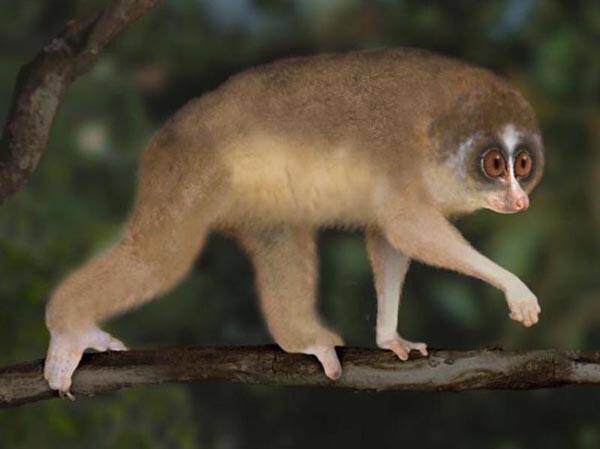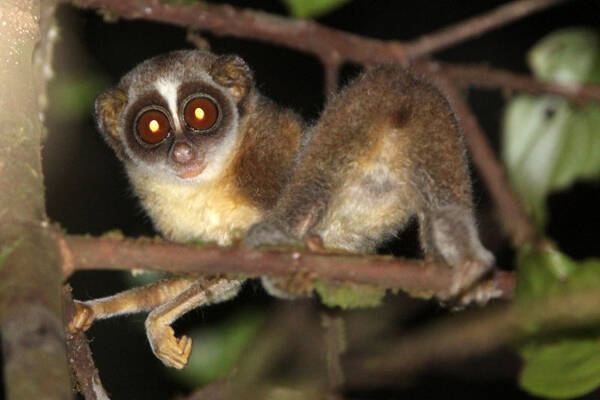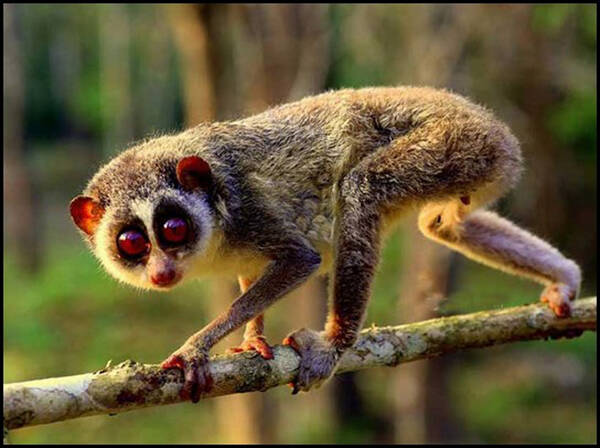Loris tardigradus
IUCN
LCBasic Information
Scientific classification
- name:Loris tardigradus
- Scientific Name:Loris tardigradus,Red Slender Loris、 Slender Loris、 Sri Lanka Slender Loris、 Sri Lanka Wet zone Slender Loris
- Outline:Primates
- Family:Loris
Vital signs
- length:18.5-25.6cm
- Weight:127-256g
- lifetime:About 12 years
Feature
Dark fur with a white stripe from forehead to nose
Distribution and Habitat
The red slow loris is a small primitive monkey found in the rainforest regions of Sri Lanka. The species is endemic to central and southwestern Sri Lanka and is usually found in the southern "wetlands" of the island up to the central "middle zone". Central Sri Lanka is known for the Horton Plains in the Nuwara Eliya district of the Central Province. The distribution range is less than 300 square kilometers.
In Sri Lanka, three subspecies of the red slow loris and one subspecies of its only relative, the gray slow loris, maintain fragmented habitat niches. The nominate subspecies inhabits the moist lowland forests of the southwest. The lowland subspecies inhabits the central hilly areas at 731-1036 meters above sea level and is considered to be mixed with the nominate subspecies at moderate altitudes in the westernmost part of its range. The highland subspecies is a rare mountain morph, found only in the mist forests of the Horton Plains above 1500 meters above se
Appearance
The red slow loris is a very small primate, 18.5-25.6 cm in length, 127-256 g in weight, with long, flexible limbs and no tail. Facial features include large, prominent ears, a short snout, and a pair of large, forward-facing eyes with hazel irises. The dark fur is distinctive, with a white stripe running from forehead to nose. The coloration of the eyelid patches and the shape of the interocular stripe differ between subspecies. The snout is sharp, ending in moist, bare skin. The red slow loris has elongated ears that are longer than those of the gray slow loris or species of the same family, the genus Slippery, and the edges of the ears are usually hairless. Females have two pairs of nipples, which are bare during lactation and covered with fur at all other times. The limbs lack strength, as the legs are clumsy and slightly longer than the arms. The palms and soles of the feet are usually bare. Like other primates, both feet have a claw on the second digit. The big toe is opposite to
Details
The red loris (scientific name Loris tardigradus), whose foreign names are Red Slender Loris, Slender Loris, Sri Lanka Slender Loris, Sri Lanka Wet zone Slender Loris, was formerly included in the "grey loris" (Loris lydekkerianus) and was promoted to fully independent in 2001 species status. There is preliminary evidence that this species also has three subspecies in wetland areas of Sri Lanka.

The average home range of red slow lorises is 3.6 hectares (36,000 square meters) for males and 1.59 hectares (15,900 square meters) for females.
Red slow lorises are nocturnal and arboreal animals. Their movements are known to be slow, smooth and silent. Tests on captive animals show that normal speed is about 0.59 meters/second. However, red slow lorises are able to climb quickly and shake branches to create noise. The method of climbing is different from that of 26% of primates. In this form of movement, the individual's speed is close to 1.2 meters/second. Red slow lorises may make "little hops," but they usually move from tree to tree via a careful cantilever, which involves grabbing a vertical branch with their hind limbs and leveling its body The ground stretched across the gap. The hip, ankle, and wrist joints are highly mobile, and unstable postures can be maintained for long periods of time because the retinal oddities provide oxygen to the limb muscles and remove cellular waste, preventing spasms. Red slow lorises usually walk on the tops of tree branches, and they prefer climbing tree forms (such as branches or vines) that are small enough to hold on to with their hands. In captured groups of red slow lorises, individuals showed extreme caution when passing through smooth vertical tree trunks 10 cm in diameter. In the same group, the phenomenon of standing on two legs on the top of a branch and hanging with hind limbs below the branch are repeatedly observed, but bipeds hanging with forelimbs are rare.
During the day, red slow lorises gather in sleeping groups, which include an adult female, her offspring, and one or more males. These associations may be stable during the night, and adult males in sleeping groups may be involved in parental care. Whether in captivity or in the wild, red slow lorises engage in social cohesion behaviors such as huddling, living together, wrestling, and biting. In addition to body language and refined olfactory communication, a variety of vocalization methods are used. In captivity, red slow lorises exchange food with each other without provoking hostility. Although aggressive behavior in captive populations is not uncommon, most aggression in the wild occurs between unrelated adult females and males that do not belong to the same sleeping group. The nocturnal activity of the red slow loris consists primarily of movement and foraging, but also includes social interactions, including between mother and infant, and rest.

Red slow lorises call each other throughout the night and sometimes even vocalize at potential predators. Known sounds of the red loris include whistles, chirps, growls, and screams. Whistles indicate excitement and aggression and are composed of one to three distinct syllables, with a decreasing frequency sweep at the end of each syllable. Whether it's a male or a female, the whistle is always loud and can be heard by humans from 100 meters away. There is evidence that whistling is most common in wild populations, possibly because long-distance communication is not required in captivity. In captivity, whistling in a cage will cause sounds from nearby caged animals. Harshness is used as a defense against threats and is sometimes associated with staring or physical pushing. Emitted primarily by females, usually in response to a male's courtship advances. The sounds, which sometimes have frequencies as high as 20 kilohertz, are composed of high-frequency monosyllables that the young use to attract their mother's attention. Sometimes male and female duets are performed with calls. A growl is a silent, threatening cry used against a predator or a prey animal. Growling is rarely given in a specific context and is usually associated with defensive body language. Screaming is used in prolonged threatening situations and is associated with brachial gland secretions.
Like many mammals and most nocturnal primates, slender slow lorises make extensive use of scent marking to convey messages. Urine marking occurs through rhythmic urination (a stereotyped behavior in which an animal travels along a branch and deposits urine at intervals by rhythmically lowering its genitals onto the substrate), anogenital dragging, and indirect application ( Urine is applied to the substrate via the hands or feet of the urinating individual). Self-cleansing with urine is often observed in a variety of situations, including before grooming pups before resting for the night, when preparing to capture harmful insects, before eating poisonous prey, and when being bitten by them. Urine marks were rarely observed near sleeping trees, but where they were within overlapping areas of range shared by members of the sleeping group, urine marks were eagerly accepted and covered. Scent communication also plays a role in direct social behavior. Grooming is usually preceded by a sniff (from male to female), and the brachial glands are often rubbed and licked during grooming.
Red slow lorises are primarily insectivores, specializing to a certain extent in preying on poisonous and unpalatable species. Venomous insects in particular are eaten with apparent disgust, insects sprayed with harsh chemicals are removed from their colonies and eaten at a distance, and red slow lorises are shed for no apparent reason. Drool, shake your head, close your eyes. There is evidence that volatile chemicals ingested with insect food may be repurposed by red slow lorises as a form of olfactory camouflage. Foraging red slow lorises are often observed flushing themselves with urine before approaching poisonous insects, perhaps to mask their scent. Red slow lorises and other slow lorises hunt by approaching quietly and cautiously, followed by a sudden and aggressive snap with one or two hands. The predatory behavior of red slow lorises has been described as a fixed pattern of behavior that begins with visual fixation of the prey, followed by ear tilting back, and finally a grasping movement, which is accomplished regardless of whether the prey is removed. In the wild, almost 100% of food is protein, including insects, tree frogs, geckos, small birds, and bird eggs. They will occasionally eat fruit if available. In captivity, red slow lorises are fed green salad and plantains and readily eat mice.

Red slow lorises breed every six months. In India, the peak breeding season of red slow lorises occurs in April-May and October-December. Sri Lanka has also reported a May-December delivery schedule. The study found no evidence of seasonality in two wild populations of red slow lorises and documented one case of a female red slow loris going into heat while her nearest neighbor was pregnant with a baby. The testes of both taxa frequently switch between scrotal and inguinal (i.e., descended and undescended) states, and no changes in the male reproductive organs were found in the female during estrus or time of year. The enlargement of male genitalia appears to be influenced by the environment.
The gestation period of red slow lorises is 166-175 days, and females give birth to up to two babies per year, usually single babies. Occasionally, a female may give birth to twins. The female will come into heat again while nursing her previous litter. The cubs remain attached to their mothers for the first 4 weeks of their lives. After four weeks, the pups are housed in a sheltered area during their nocturnal periods. Weaning time is approximately 185 days, when the pups have reached adult size. At birth, baby red slow lorises are helpless. They instinctively cling to their mother's fur and stay there day and night for at least four weeks. Four weeks later, the red slow lorises "parked" their young on densely packed branches during their nocturnal foraging activity. Male assistance in nocturnal parenting may increase the activity of lactating mothers while foraging, helping them meet their high caloric expenditure. The female will return every hour during the night to where she laid her cubs.
The red slow loris is listed as "endangered" because its species size, as of 2008, was estimated to be less than 2,500 mature individuals, and the observed number of mature individuals continues to decline, with no subpopulation containing more than 250 individuals. Mature individuals.
Listed in the "World Conservation Union Red List of Threatened Species" (IUCN) 2008 ver 3.1 - Endangered (EN).
Protect wild animals and eliminate wild game.
Maintaining ecological balance is everyone’s responsibility!








